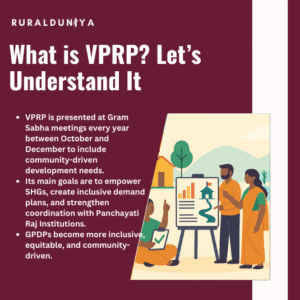Have you ever wondered what drives farmers to leave their fields and march on highways, cities, and capitals? Farmers protest in India is not just about slogans and rallies; they are a fight for survival, fairness, and dignity.
In this article, we’ll uncover why these protests happen, what they demand, and how they’ve shaped laws and policies. Dive in to explore a journey of resilience that goes beyond borders.
Understanding Farmers Protests: Why They Rise
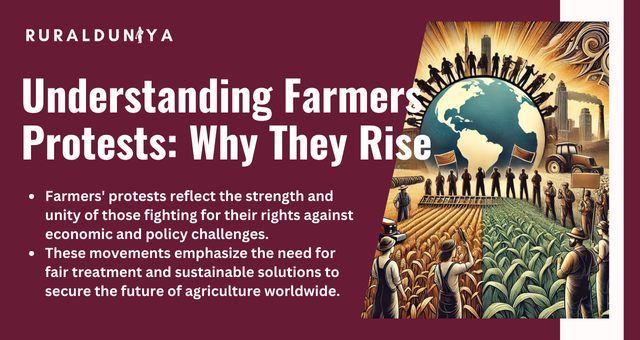
Farmers protest India is a powerful expression of resilience, unity, and the fight for survival in the face of adversity. Across the globe, farmers have come together to challenge policies and practices that they believe threaten their livelihoods, dignity, and future.
These movements, whether in bustling capitals or rural highways, highlight the struggles of those who work tirelessly to feed the world.
In recent years, protests have grown in scale and impact, reflecting deep-rooted issues like economic inequality, unfavorable trade deals, and environmental regulations.
From India’s historic demonstrations over farm laws to European farmers rallying against trade agreements, these protests underline the need for fair policies and sustainable solutions.
Protests are not just about individual grievances; they are about securing the rights and recognition of one of the most essential communities in society.
Why Do Farmers Protest?
Farmers work tirelessly to feed us, yet they face countless hurdles. Here are the main reasons they protest:
- Money Worries: With rising costs of seeds, fertilizers, and water, combined with low crop prices, many farmers find it hard to make ends meet.
- Unfair Policies: New laws, especially those related to land or market reforms, often disrupt their traditional practices and income sources.
- Environmental Rules: While aiming to protect nature, some rules increase farmers’ costs without offering alternatives.
- Trade Pressures: International agreements can flood local markets with cheaper imports, pushing farmers into unfair competition.
Farmers Protests in India
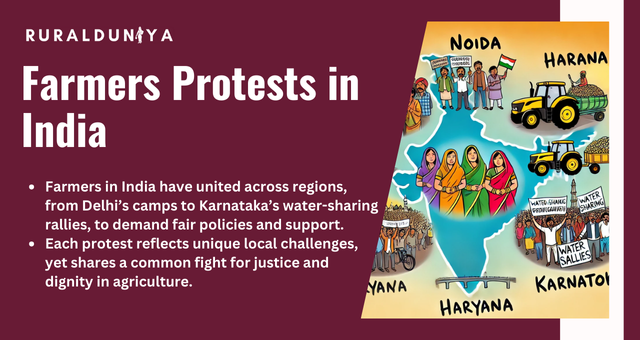
India is no stranger to massive farmers’ movements. Let’s take a closer look at some major hotspots.
Delhi – The Protest Capital
Delhi has been the heart of India’s farmer protests. In 2020–2021, farmers from Punjab, Haryana, and other states camped on its borders for months.
Why? They feared three new farm laws would take away their guaranteed crop prices. Even in 2024, farmers returned to demand legal Minimum Support Prices and relief from rising debts.
Noida – The Neighboring Battleground
Farmers in Noida, close to Delhi, protested for fair compensation for land acquisitions and better policies. They blocked roads and held rallies, drawing attention to their plight.
Haryana – The Gateway of Movements
In Haryana, protests often begin with highway blockades. Farmers here have a history of organizing large demonstrations, standing shoulder-to-shoulder for their rights.
Karnataka – Protests in the South
Farmers in Karnataka have different but equally urgent issues, such as disputes over water-sharing and demands for debt waivers. They too march, rally, and fight for justice.
Looking Back: Farmers Protests Through the Years
Looking back at protests through the years reveals the enduring resilience and determination of farmers fighting for their rights and livelihoods.
2020 – A Year That Changed Everything
The 2020–2021 protests in India were a turning point. Farmers braved harsh winters, heavy rains, and scorching heat to demand the repeal of three farm laws. After a year of peaceful demonstrations, their determination paid off – the laws were repealed.
2024 – History Repeats
In 2024, similar issues resurfaced. Farmers gathered again, seeking MSP guarantees and stronger financial support. Their message was clear: their voices cannot be ignored.
Farmers Protests Around the World
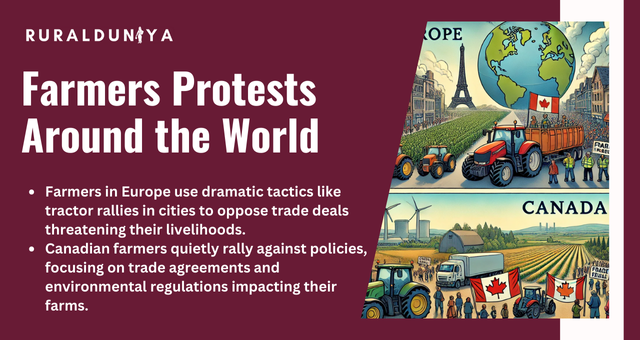
Protests around the world highlight shared struggles against policies and challenges impacting their livelihoods, uniting them across borders.
Europe – The Tractor Rallies
Farmers in Europe, especially in countries like France and Germany, have unique struggles. In 2024, they protested against a trade deal that would allow cheaper imports from South America, threatening their incomes. They used tractors to block roads and gather in major cities like Paris and Brussels.
Canada – Quiet but Powerful
Canadian farmers, too, have rallied against policies they feel don’t consider their needs. Trade agreements and stricter environmental rules often take center stage in their protests.
Issues That Spark Protests
Issues that spark protests often stem from economic hardships, unfair policies, and the fight for sustainable agricultural practices.
Farm Laws and MSP
Farm laws in India have often been at the core of protests. Farmers fear these laws would weaken their income and leave them dependent on corporations. Demanding MSP guarantees has become a recurring theme.
Land and Water Battles
Protests along the Yamuna Expressway in India highlight the issue of fair compensation for land acquisition. Similarly, water-sharing disputes have led to demonstrations in Karnataka and other states.
Facing Violence and Hardship
While most protests are peaceful, farmers sometimes face water cannons, barricades, and even clashes with police. Despite this, they continue to march and make their voices heard.
Power of the Farmers Protest March
Did you know that marches are one of the most powerful tools for farmers? From Delhi’s “Chalo Delhi” movement to tractor parades in Europe, these marches show unity and determination. They’re not just about walking; they’re about sending a message loud and clear.
Farmers Protests in the News
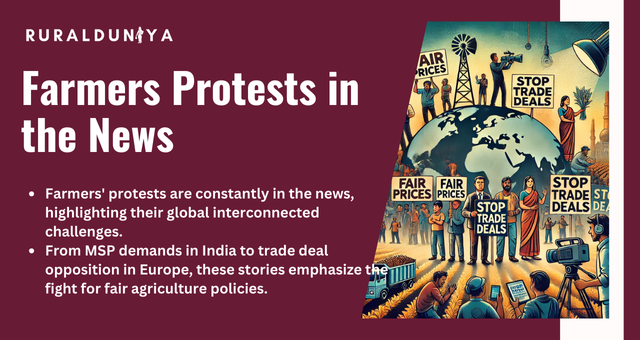
Turn on the news, and you’ll likely hear about protests somewhere in the world. Be it Indian farmers demanding MSP or European farmers fighting trade agreements, these stories remind us how interconnected the world of agriculture truly is.
What Can We Learn from Farmers Protests?
Farmers protests teach us that change isn’t easy, but it’s possible when people unite for a common cause. These movements have not only shaped laws and policies but also brought global attention to the struggles of those who feed us.
Summary: A Call for Justice and Respect
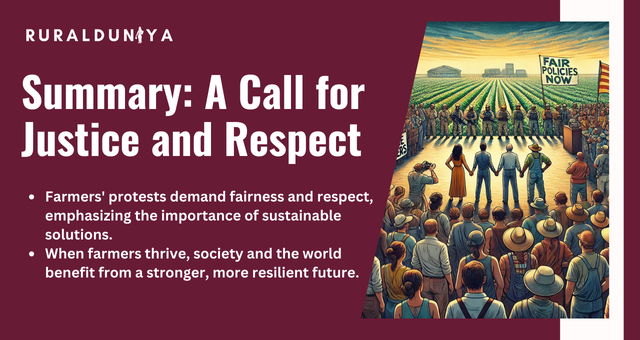
Farmers protest India is more than demonstrations; they’re a call for fairness, respect, and sustainable solutions. Governments must listen to their voices and create policies that ensure their survival and dignity. After all, when farmers thrive, the world thrives.
So, the next time you hear about a farmers protest, take a moment to understand their journey. It’s not just about fields and crops – it’s about resilience, unity, and the fight for a better future.
FAQs
Why do farmers protest?
Farmers protest when they feel their livelihood is at risk. Common reasons include unfair policies, low crop prices, land acquisition disputes, or lack of support from the government.
What were the main reasons for the 2020-2021 farmer protests in India?
The 2020-2021 farmer protests in India were primarily against three farm laws. Farmers believed these laws would remove guaranteed crop prices (MSP) and leave them vulnerable to exploitation by big corporations.
Are farmer protests only happening in India?
No, farmer protests happen worldwide. For example, European farmers have protested strict environmental rules, and Canadian farmers have raised concerns about subsidies and trade policies.
What is MSP, and why is it important for farmers?
MSP, or Minimum Support Price, is a fixed price set by the government to ensure farmers get a fair value for their crops. It protects them from market fluctuations and exploitation.

Nishank is a social impact enthusiast with a solid foundation in public policy, micro-enterprise, and agribusiness. Growing up in a farmer’s family has given him a profound connection to rural communities, fueling his passion to empower people towards self-reliance. He completed his undergraduate studies at the Delhi University and earned a master’s degree in Rural Management from National Institute of Rural Development & Panchayati Raj in Hyderabad.

